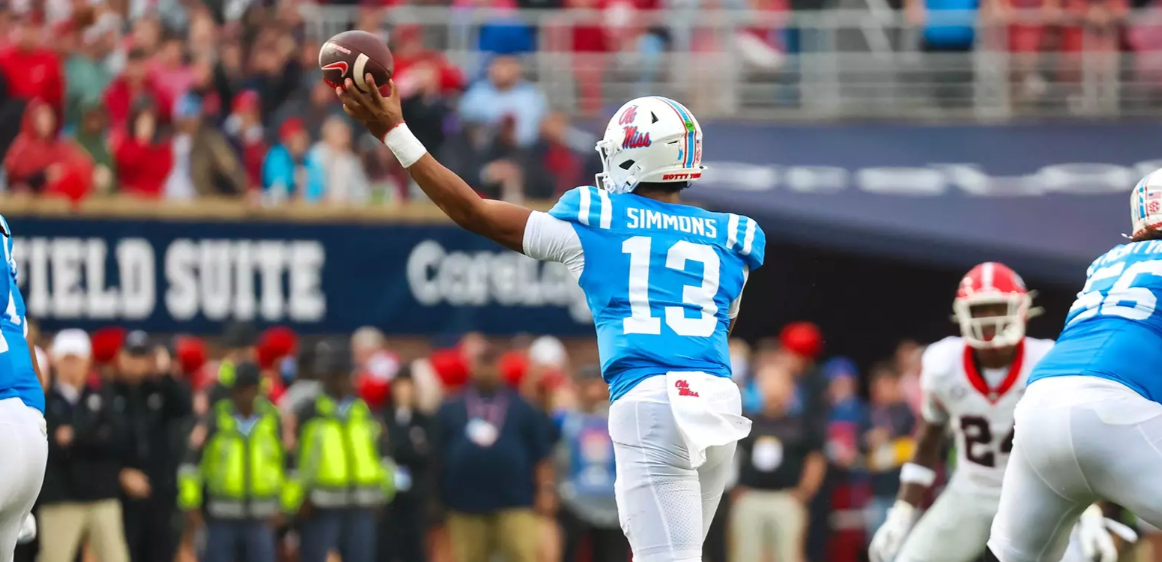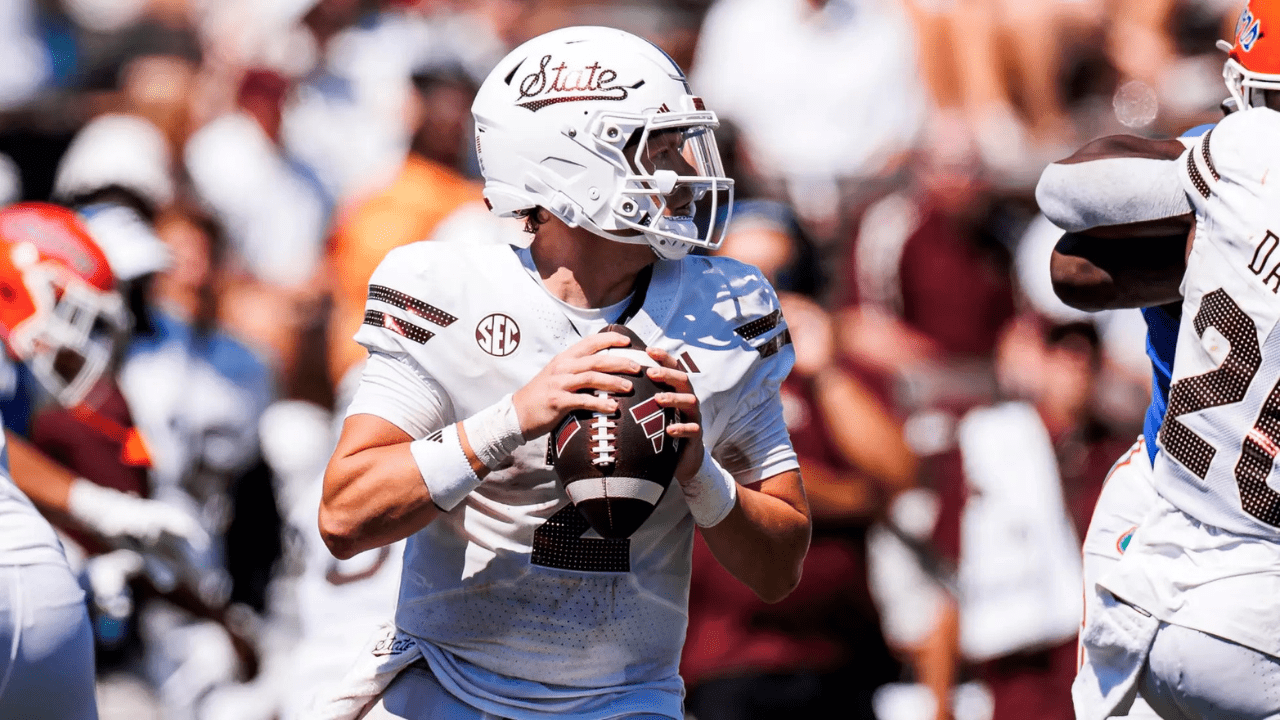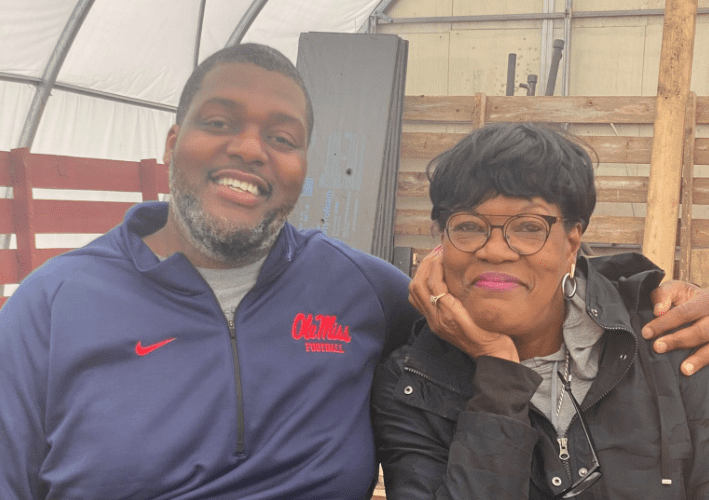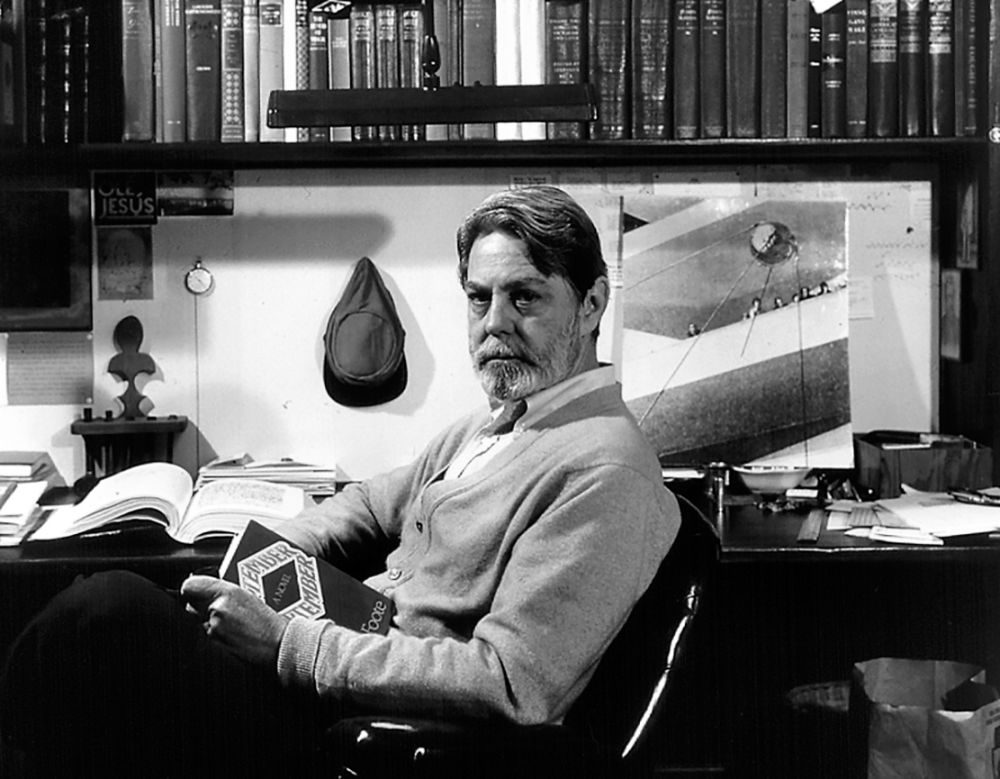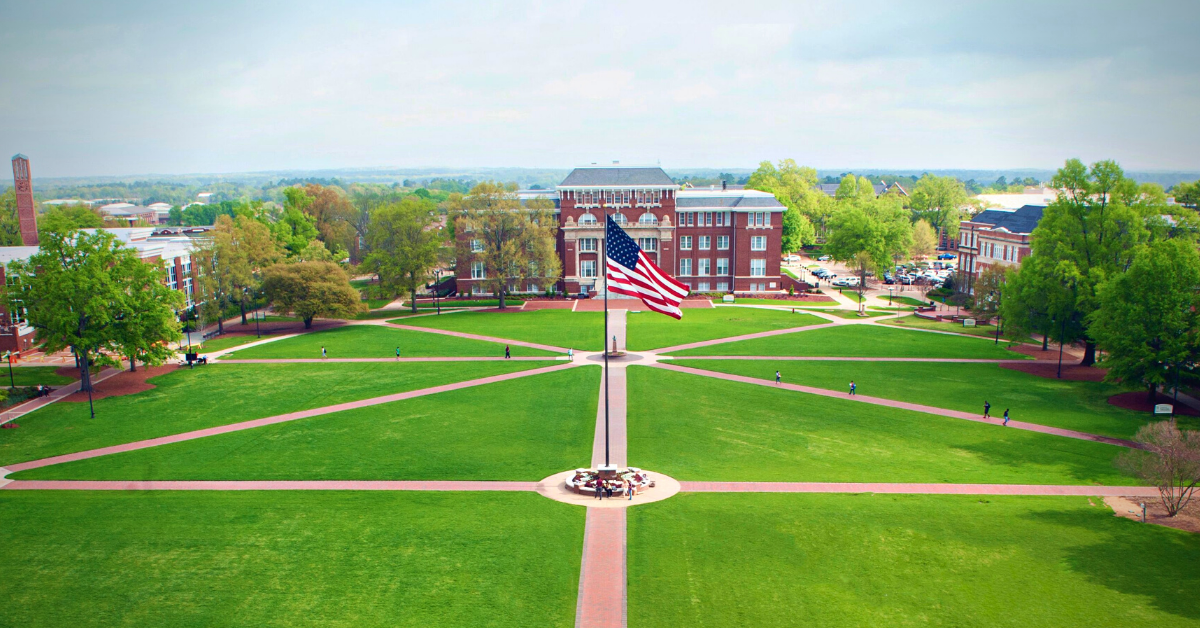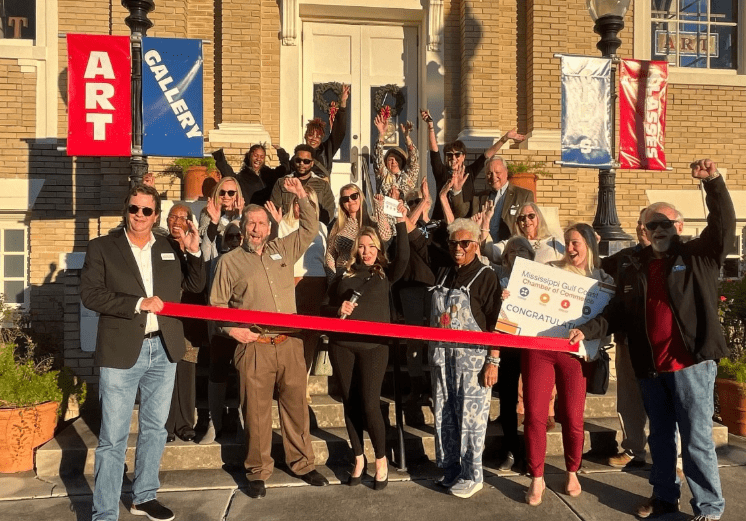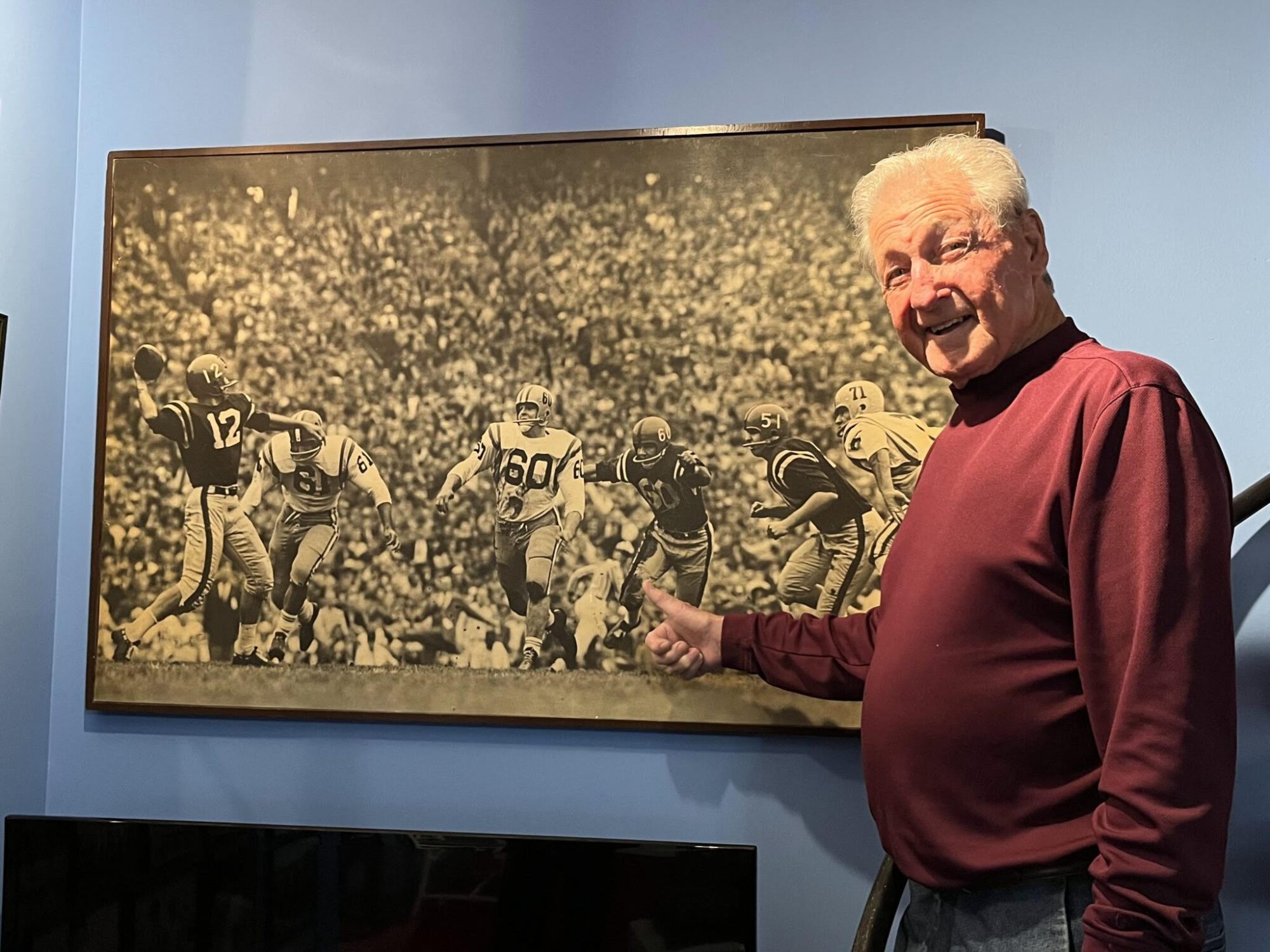
Jake Gibbs pointing to a photograph of him at quarterback for Ole Miss in the 1960 Sugar Bowl against LSU.
A superstar on the baseball diamond and gridiron, Jake Gibbs remains a legendary reminder of the era that put Ole Miss on the map.
College football is fast approaching, and Ole Miss coach Lane Kiffin has what many of his peers crave – depth and talent at quarterback.
Some of that talent is proven at the Power Five level, some of it is youthful potential.
None of it signed with Ole Miss right out of high school.
The game’s shifting landscape has created unlikely unions between traditional schools and big money conferences. It has also created departures that will likely kill the 108-year-old Pac-12 Conference.
Through Name, Image and Likeness college football players are paid, many of them quite well.
The Transfer Portal leads to roster turnover as players often have less patience with words like development and experience.
In the New CFB Order savvy Portal management can potentially yield quick benefits.
What it takes away, in many instances, is the guy on the hill.
That’s where Jake Gibbs sat one weekday afternoon in the fall of 1965.
He had finished his responsibilities as a catcher with the Yankees and had returned home to Grenada. He told his wife he thought he’d drive up to Oxford and watch football practice.
Gibbs will turn 85 this November days before the Egg Bowl. He remains in good health and makes an occasional public appearance when asked.
Fewer people ask for Gibbs in 2023, but they knew who he was in the 1960s.
Not as Tall as Advertised
“You ain’t 6-feet tall,” was the greeting he received from Clete Boyer, the Yankees third baseman, when Gibbs arrived in the Bronx for the first time.
Boyer knew this kid was coming, a football All-American who was drawing interest from multiple NFL teams. Football chased Jake Gibbs, but he played hard to get.
Houston’s pro franchises were working in tandem to sign the brash, elusive Mississippi kid of indeterminate height. MLB’s Colt 45s – the forerunner of the Astros – told Gibbs they’d sign him to a baseball contract with the idea that if he didn’t pan out they’d let the NFL’s Oilers have him.

“I said, ‘Hell no, I don’t want that, to be switching back and forth and have that on my mind. I wanted to sign one place and stay there.”
So the man on the hill picked baseball, fulfilling a dream that traced its origins to Highway 8 in North Mississippi – suburban Grenada if you will – where Gibbs showed off his athleticism and toughened up by playing with older boys.
“I wanted to play baseball. The dream was still there,” he said.
Gibbs, a catcher, signed for $100,000 and spent four years in the minor leagues. He played with the big club from 1965-1971 mostly backing up Yankee greats Elston Howard and Thurman Munson. He was a career. 233 hitter with 25 home runs, but his handling of pitchers was so valued by MLB’s most historical franchise that upon his retirement the Yankees hosted a “Jake Gibbs Day” in his honor then sent him off to manage in their farm system. That’s where he coached Derek Jeter.
Putting on the pinstripes remains the greatest thrill of his decorated athletics career, Gibbs tells friends.
But Boyer was right. Regardless of what Ole Miss sports publicists said, Gibbs wasn’t 6-feet tall.
“I told him, ‘No, I’m 5-11,” Gibbs said.
The missing one inch didn’t bother Gibbs on the football field.
He went 23-3-1 as the Ole Miss starting quarterback, his most success coming in 1959 and 1960 at the height of John Vaught’s legendary run.
He knew when to give, to keep or to pitch in Vaught’s sprint-out option offense.
And he knew why his beloved coach was losing his cool with his quarterbacks that day.
Some on-the-ball manager who had spotted Gibbs told Vaught who was watching from up on the hill.
Vaught waved him down to where the action was.
From his elevated perch Gibbs could see it all. He knew the quarterbacks, particularly a former high school defensive back that Vaught was working to convert, were getting the concepts of the offense but were applying them too slowly.
Vaught thought an illustration from Gibbs would be worth a thousand words.
“I went down there, and coach Vaught said, ‘Hey guys, this is one of my former quarterbacks, Jake Gibbs. He was a good one.’ He said, ‘I’m having quarterback problems, Jake. Get under center.’”
“I had on a white shirt, cuff links and street shoes. I was dressed up on that Wednesday. He said, ‘Get under center and show these guys how to run 36 Slant.’”
“I said, ‘Coach I haven’t thrown a football in five years.’ He said, ‘I don’t give a damn, get under the center.’ That was all it took. I wasn’t going to argue with him.”
The next day Gibbs got a call from Vaught’s secretary who asked if he could meet with Vaught at 11 a.m. Saturday before the SEC opener against Vanderbilt.
The meeting was brief, and when Gibbs left he’d been hired as quarterbacks coach for $500 a month.
These days many NIL contracts are worth much more.
Drawn Back to Campus
What sets it apart from evolving college football is that Gibbs went back. He wanted to go back. His college football days were over, but he wanted to be on campus again.
Fans want players to perform, yes, but they want players to feel. Fans want players to appreciate colors changing in the Grove, walks to class and parties after the games.
Adults connect with their college days for years. That’s why club seating and other amenities exist in SEC stadiums.
When the passes, catches, touchdowns and tackles are complete the memories begin.
That mattered to Gibbs, but it’s hard to make a deep connection if you’re in a place only one or two seasons.
Gibbs wanted to help his former coach.
“They were taking eight, nine and 10 steps before they ever threw the ball. By then you’re almost out of bounds. So I said, ‘Look you’ve got to be quick. I took four steps and hit the (receiver),’” Gibbs said.
“Run it again,” Vaught yelled.
Gibbs ran the play eight times and completed eight pass attempts.
“I about worked up a sweat,” he said.
Before Gibbs became Ole Miss’s baseball coach in the 1971-72 academic year he would coach quarterbacks for five more seasons.
It was Gibbs who taught Vaught’s offense to Archie Manning.
Manning said it was a “thrill” to work with Gibbs, whose football career he followed while growing up in Drew.
‘Serious Stuff’ with Archie
In the summer of 1970 Yankees manager Ralph Houk had news for his backup catcher that was about to get him cranked up.
Houk knew of Gibbs’ second job as Ole Miss quarterbacks coach. The White Sox were in town, and Houk sent word to the bullpen during batting practice for Gibbs to join him and White Sox General Manager Ed Short behind home plate.
“Oh shoot, I thought Thurman must be sick,” Gibbs recalled.
Instead, Short had asked Houk to summon Gibbs. The White Sox liked Manning as a baseball prospect. They’d drafted him and wanted Gibbs to convince him to sign.

“I said, ‘Ralph, don’t mess with me on this. This is serious stuff.’”
Gibbs didn’t waste time with small talk after a quick introduction to Short.
“I said, ‘If y’all go down there and sign Archie you ain’t going to be allowed in the state of Mississippi again. I’m serious,’” Gibbs recalled.
“He said, ‘Jake, we like him.’ I don’t guess Archie signed.”
The White Sox liked Manning so much that when they used their third-round pick in 1970 it was actually the second time they’d drafted him.
The Role of Gibbs, Teammates in Changing Times
As a senior quarterback in 1960 Gibbs was an All-American and the SEC Player of the Year. The Rebels went 10-0-1 and were named national champions by the Football Writers Association of America. He was third in the Heisman Trophy voting in 1960.
He was part of an Ole Miss SEC baseball championship team in 1959.
Gibbs went 485-389-8 coaching Ole Miss baseball from 1972-1990. He led the Rebels to the College World Series in 1972 and was a two-time SEC Coach of the Year.
He’s seen a lot of change in college football.
“There’s more overall speed than we had, and the size is different. There are some big ’ol boys out there playing, and those big ’ol boys can run, but it’s still about ability and how you prepare.”
There are other changes that the guy on the hill never considered during his Ole Miss playing days, changes like a football coach making $9 million, as Kiffin will this season.
Gibbs believes he and his teammates have a small role in Kiffin’s salary.
“If Ole Miss didn’t have the history that’s here … I’ve always sensed great support, great effort to get back to those days. I’ve always sensed that around here,” Gibbs said. “I think a lot of that is attributed to the success and the passion that people had for those teams.”
